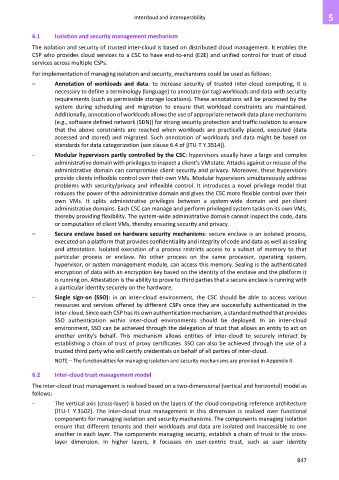Page 855 - Cloud computing: From paradigm to operation
P. 855
Intercloud and interoperability 5
6.1 Isolation and security management mechanism
The isolation and security of trusted inter-cloud is based on distributed cloud management. It enables the
CSP who provides cloud services to a CSC to have end-to-end (E2E) and unified control for trust of cloud
services across multiple CSPs.
For implementation of managing isolation and security, mechanisms could be used as follows:
– Annotation of workloads and data: to increase security of trusted inter-cloud computing, it is
necessary to define a terminology (language) to annotate (or tag) workloads and data with security
requirements (such as permissible storage locations). These annotations will be processed by the
system during scheduling and migration to ensure that workload constraints are maintained.
Additionally, annotation of workloads allows the use of appropriate network data plane mechanisms
(e.g., software defined network (SDN)) for strong security protection and traffic isolation to ensure
that the above constraints are reached when workloads are practically placed, executed (data
accessed and stored) and migrated. Such annotation of workloads and data might be based on
standards for data categorization (see clause 6.4 of [ITU-T Y.3514]).
– Modular hypervisors partly controlled by the CSC: hypervisors usually have a large and complex
administrative domain with privileges to inspect a client’s VM state. Attacks against or misuse of the
administrative domain can compromise client security and privacy. Moreover, these hypervisors
provide clients inflexible control over their own VMs. Modular hypervisors simultaneously address
problems with security/privacy and inflexible control. It introduces a novel privilege model that
reduces the power of the administrative domain and gives the CSC more flexible control over their
own VMs. It splits administrative privileges between a system-wide domain and per-client
administrative domains. Each CSC can manage and perform privileged system tasks on its own VMs,
thereby providing flexibility. The system-wide administrative domain cannot inspect the code, data
or computation of client VMs, thereby ensuring security and privacy.
– Secure enclave based on hardware security mechanisms: secure enclave is an isolated process,
executed on a platform that provides confidentiality and integrity of code and data as well as sealing
and attestation. Isolated execution of a process restricts access to a subset of memory to that
particular process or enclave. No other process on the same processor, operating system,
hypervisor, or system management module, can access this memory. Sealing is the authenticated
encryption of data with an encryption key based on the identity of the enclave and the platform it
is running on. Attestation is the ability to prove to third parties that a secure enclave is running with
a particular identity securely on the hardware.
– Single sign-on (SSO): in an inter-cloud environment, the CSC should be able to access various
resources and services offered by different CSPs once they are successfully authenticated in the
inter-cloud. Since each CSP has its own authentication mechanism, a standard method that provides
SSO authentication within inter-cloud environments should be deployed. In an inter-cloud
environment, SSO can be achieved through the delegation of trust that allows an entity to act on
another entity's behalf. This mechanism allows entities of inter-cloud to securely interact by
establishing a chain of trust of proxy certificates. SSO can also be achieved through the use of a
trusted third party who will certify credentials on behalf of all parties of inter-cloud.
NOTE – The functionalities for managing isolation and security mechanisms are provided in Appendix II.
6.2 Inter-cloud trust management model
The inter-cloud trust management is realized based on a two-dimensional (vertical and horizontal) model as
follows:
– The vertical axis (cross-layer) is based on the layers of the cloud computing reference architecture
[ITU-T Y.3502]. The inter-cloud trust management in this dimension is realized over functional
components for managing isolation and security mechanisms. The components managing isolation
ensure that different tenants and their workloads and data are isolated and inaccessible to one
another in each layer. The components managing security, establish a chain of trust in the cross-
layer dimension. In higher layers, it focusses on user-centric trust, such as user identity
847

